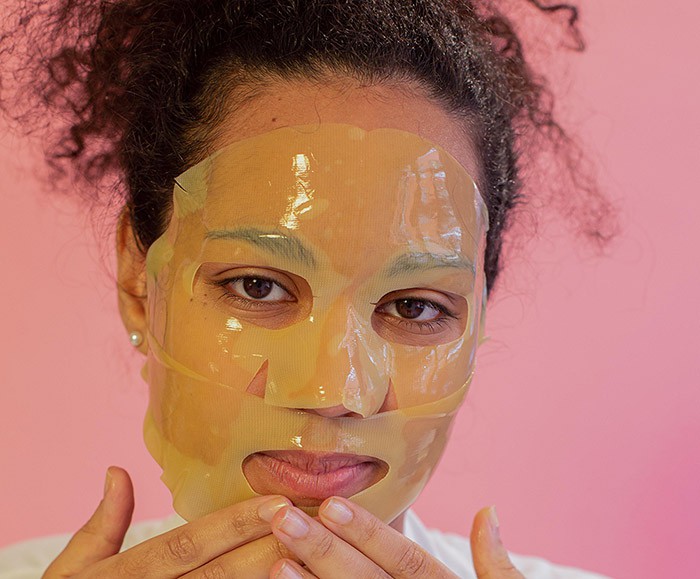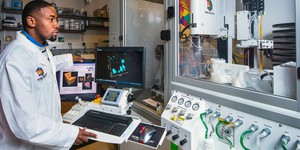Testing the Hydrating Power of Hydrogel Face Masks
Abstract
Do you care about the look and feel of your skin? Then you probably know that your skin prefers to be well hydrated (moisturized). Dry skin often cracks, gets inflamed easily, and looks dull. If you go to the store, you will find many skin care products that promise to hydrate your skin. Among them are cosmetic face masks (sometimes called facial masks) that you put on your face to provide the skin with water and nutrients. In this science project, you will make your own hydrogel face masks using different ingredients and investigate how they change your skin's moisture.Summary
Objective
To investigate the effect of glycerin in hydrogel face masks on skin moisture.
Introduction
Did you know that your body's largest organ is the skin? It makes up about 15% of your body weight! Your skin is very important because it protects you from germs, helps control your body temperature, and lets you sense things through touch. To take care of your skin, it is important to keep it hydrated, which means making sure it has enough water in it. Water is necessary for the skin to be healthy and function normally. If your skin does not have enough water, it can become dry and cracked, as shown in Figure 1, and lines and wrinkles might appear over time. Without enough moisture, skin starts to look dull and old.
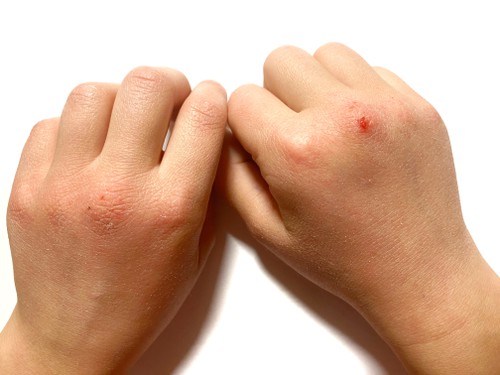 Image Credit: Pixabay user / Pixabay LIcense
Image Credit: Pixabay user / Pixabay LIcense
Figure 1. Dry skin begins to crack and becomes irritated or inflamed.
The cosmetics industry has developed many skin care products that promise to hydrate the skin. Moisturizers, lotions, creams, serums, oils, and gels are some examples of products that you can buy for your skin. One popular product for the skin on your face is a facial mask or face mask. Facial masks are sold as a quick treatment for the skin on your face and are only meant to be left on for 15-20 minutes. There are different types of facial masks, like wash-off masks, sheet masks, and hydrogel masks (Figure 2).
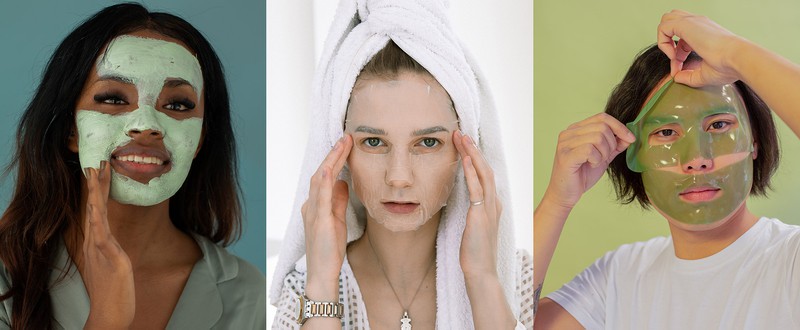 Image Credit: https://www.pexels.com/license/
Image Credit: https://www.pexels.com/license/The wash-off mask is a green, paste-like substance that is spread on the face. The sheet mask is made of a thin, papery material that adheres to the skin when wet. The hydrogel mask is made of a stretchy gelatinous material that clings to the face.
Figure 2. Face masks—including wash-off face masks (left), sheet masks (middle), and hydrogel masks (right)—promise to hydrate your skin.
Hydrogel is a jelly-like material that can hold a lot of water. It is made of special polymers — long chains of molecules — that can absorb and retain a lot of water. You might be familiar with hydrogels in the form of water gel beads (shown in Figure 3), which grow significantly in size when put in water.
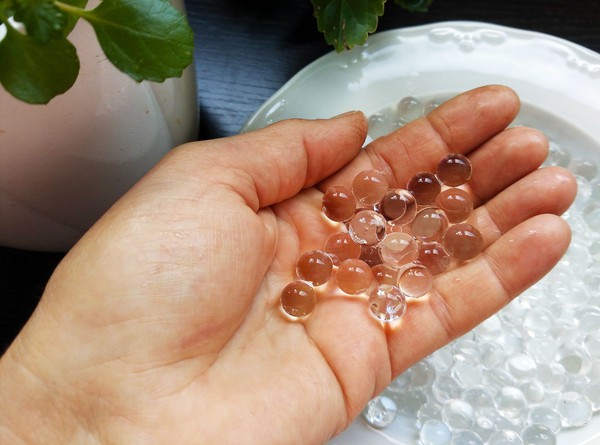 Image Credit: Pixabay user / Pixabay LIcense
Image Credit: Pixabay user / Pixabay LIcense
Figure 3. Water beads that grow when put in water are examples of a hydrogel.
Scientists have found that ingredients like some vitamins, oils, herbs, and fruit extracts can help hydrate the skin. Often they are used as ingredients in commercial facial masks. You can read more about them in the Bibliography. Since the main goal of most face masks is skin hydration, almost all face masks contain special hydrating ingredients. These ingredients are called humectants. Humectants are substances that can hold onto water very well and pull it to your skin. Two common humectants are glycerin and hyaluronic acid.
In this science project, you will make your own hydrogel face masks using collagen, which is a protein that our bodies make. Collagen hydrogels are not only used for face masks in the cosmetic industry. They also play an important role in medicine as wound dressings to heal cuts, sores, and burns. For this science project, you will make one face mask with glycerin and one without. Then, you will measure your skin moisture before and after using each face mask to see whether one hydrates your skin better. You will use a special tool called a skin moisture detector to measure the amount of moisture in your skin.
Skin moisture content is often reported as a percentage (%). The moisture detector classifies a skin moisture content between 30-45% as normal. As this is a relatively narrow range, a change of 1–2% in skin moisture already makes a big difference. Do you think your skin moisture will change after using the hydrogel face masks with and without glycerin? Find out by doing the experiment!
Terms and Concepts
- Hydration
- Hydrogel
- Polymer
- Humectant
- Glycerin
- Hyaluronic acid
- Collagen
Questions
- Why is it important to keep our skin hydrated?
- How do face masks help hydrate the skin?
- What are hydrogels and how are they used in the cosmetic industry?
- What are humectants and why are they an important ingredient in facial masks?
Bibliography
- Dr. Winter. (2016, March 7). The Importance Of Keeping Your Skin Hydrated. Dermatology Center of Washington Township. Retrieved March 14, 2023.
- Chao, J. (n.d.). The Ultimate Guide to Sheet Mask Ingredients. Glowieco.com. Retrieved March 14, 2023.
- Frothingham, S. (2022, March 31). Is Glycerin Good for Your Skin & Face? Healthline. Retrieved March 14, 2023.
- Carpenter, K.G. (2022, November 21). Explainer: What is a hydrogel? Science News Explores. Retrieved March 14, 2023.
For help creating graphs, try this website:
- National Center for Education Statistics, (n.d.). Create a Graph. Retrieved June 25, 2020.
Materials and Equipment
- Stove
- Pots with lid (2)
- Masking tape
- Marker
- Measuring spoons
- Distilled water (about 500 milliliters), available in the bottled water section of most grocery stores
- Chamomile teabags (6)
- Measuring spoon, ½ teaspoon
- Vegetable glycerin, food or cosmetic grade, available in most grocery stores
- Collagen tablets for face masks, about 1.3 g each (6); Note: these tablets are for face mask making only. They cannot be eaten!
- Face mask mold (2)
- Spoon (2)
- Timer
- Sharp knife
- Adult helper
- Tap water
- Soap
- Towel
- Skin moisture detector. One example is the MiLi Smart Skin Moisture Detector. This device requires the download of an app.
- Paper towels
- Mirror
- Pen or pencil
- Lab notebook
Disclaimer: Science Buddies participates in affiliate programs with Home Science Tools, Amazon.com, Carolina Biological, and Jameco Electronics. Proceeds from the affiliate programs help support Science Buddies, a 501(c)(3) public charity, and keep our resources free for everyone. Our top priority is student learning. If you have any comments (positive or negative) related to purchases you've made for science projects from recommendations on our site, please let us know. Write to us at scibuddy@sciencebuddies.org.
Experimental Procedure
Making the Hydrogel Masks
Follow the instructions below to make both of your face masks. You can also view the basic steps of how to make a hydrogel face mask in the Make Your Own Cosmetic Face Mask video.
- Place both face mask molds on a flat surface that can tolerate spills and heat. Use the marker and masking tape to label the face mask molds "+ glycerin" and "- glycerin." You can tape the label on the back of the molds.
- Use the marker and masking tape to label your two pots "+ glycerin" and "- glycerin."
- Add 5 tablespoons of distilled water to the "- glycerin" pot.
- Measure 4 ½ tablespoons of distilled water to the "+ glycerin" pot. Note: You will add ½ tablespoon less distilled water here, as you add ½ tablespoon of glycerin to this recipe in the next step. The total amount of liquid should be the same in both recipes as it is one of the controlled variables in this experiment.
- Add ½ tablespoon vegetable glycerin to the "+ glycerin" pot and mix the water and glycerin with a spoon.
- Add one chamomile teabag to each pot.
- Place the "- glycerin" pot on the stove and put the lid on. Ask an adult for help when working with the stove and hot liquids. On the stove, bring the water to a boil.
- Once the water boils, remove the pot from the stove. Remove the teabag with a spoon. Squeeze the teabag and collect the water in the pot.
- Add one collagen tablet to the hot liquid. Swirl the liquid until the collagen tablet has fully dissolved. Note: It is ok if there are still some tiny bits of the tablet floating around.
- Pour the face mask.
- While still hot, carefully pour the liquid into the face mask mold you labeled "- glycerin." When pouring, move the pot over the mold so the liquid gets into all areas of the mold.
- Use a clean spoon to spread the liquid in the mold. Make sure the whole mold area is covered. You can also shake or tilt the mold a little to spread the liquid out.
- Note: You have to be quick in this step, as the liquid will start to become solid. If the liquid solidifies before you are able to spread it out in the face mask, you have to discard the face mask and make a new one. The mask with glycerin will solidify faster than the mask without. One way to prevent early solidification of your mask is to place the face mask molds on a warm or hot surface such as a warm baking tray. If you do this, make sure the surface is flat. Otherwise, the liquid will spill out of the mask mold.
- The poured mask should look like in Figure 4.
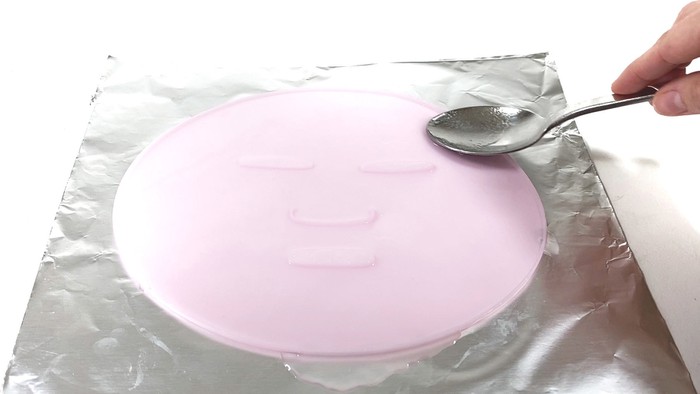 Image Credit: Svenja Lohner, Science Buddies / Science Buddies
Image Credit: Svenja Lohner, Science Buddies / Science Buddies
Figure 4. Prepared face mask in the mold.
- Repeat steps 7–10 with the "+ glycerin" mixture and the "+ glycerin" face mask mold. Remember that the mixture with glycerin will solidify faster.
- Once both masks are poured into the mold let them set for at least 15 minutes to fully solidify.
Testing Your Masks and Measuring Skin Hydration
To be able to compare the face mask with and without glycerin at the same time, you will cut your face masks in half. Then you will place one half of the "+ glycerin" face mask on one side of your face and one half of the "- glycerin" face mask on the other side of your face. You will do three separate trials for each face mask to make sure you can trust your data.
- While waiting for the masks to set, familiarize yourself with the skin moisture detector. Some of the devices need an app to function. With the permission of an adult, download the app. Then follow the device instructions to set it up. Do a couple of test measurements so you are familiar with how the device works. You will measure the skin moisture in your face, so if needed, adjust the settings accordingly.
- Make a data table like Table 1 in your lab notebook. You will use it to record your skin moisture measurements before and after you apply your face masks. Write down in your data table which face mask you will put on which side of your face. You will need to make a separate data table for each trial.
| Measurements Trial _____ | ||||
|---|---|---|---|---|
| Skin moisture measurement | Face mask with glycerin: ___________ | Face mask without glycerin:__________ | ||
| Before mask treatment | After mask treatment | Before mask treatment | After mask treatment | |
| 1 | ||||
| 2 | ||||
| 3 | ||||
| 4 | ||||
| 5 | ||||
- Once the 15 minutes are over, your face masks are ready. With a sharp knife, cut along the lines around the eye, mouth, and nose features in the mask mold. Also, cut around the edges of the face mask. This will prevent the mask from sticking to the edges of the mold when removing it from the mold.
- Wash your whole face with warm tap water and soap. Then dry your face with a towel.
- Set a timer for 5 minutes and start it. During the 5 minutes, don't go outside, walk around, or expose your face to wind or heated air.
- Once the five minutes are over, do the skin moisture measurements before mask treatment.
- Use the skin moisture detector to measure your skin moisture at five different places on your left cheek and five different locations on the right cheek.
- Measure below your cheekbones and clean the detector with a paper towel between measurements.
- Record the measurements in your data table. Pay attention to which side you are going to place each face mask on.
- Now it's time to apply your face masks!
- With a sharp knife and with adult supervision, cut both face masks in half inside the face mask mold. Cut right between the eyes from top to bottom.
- Carefully remove one half of the face mask without glycerin from the mold. Remove it slowly, so it doesn't break. It should look like the mask in Figure 5.
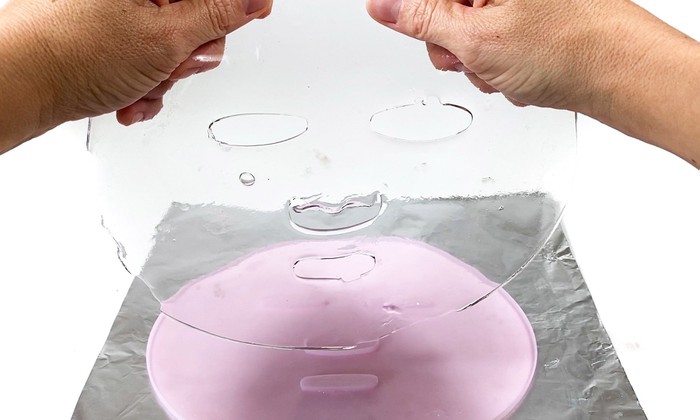 Image Credit: Svenja Lohner, Science Buddies / Science Buddies
Image Credit: Svenja Lohner, Science Buddies / Science Buddies
Figure 5. A solidified hydrogel face mask removed from the face mask mold. - Place the half face mask on the side of your face you chose for the "- glycerin" face mask. Align the eye hole with your eye, and then pat the face mask down on your face. Smooth away any wrinkles and remove air bubbles underneath the face mask with your fingers. The mask should lay flat on your skin and cover all relevant areas, especially your cheek. Be careful not to cover your nose and mouth! You still need to be able to breathe! It might be helpful to do this step in front of a mirror.
 Notes for face mask application:
Notes for face mask application:
- When you put on the face mask, do not cover your nose or mouth with the face mask. You still need to be able to breathe while wearing the mask.
- The face mask should only be applied for 10-15 minutes.
- Very rarely, people can be allergic to collagen. If you feel a burning, tingling, or itching sensation when the face mask is on your face, remove it immediately and rinse your face with warm water and soap.
- Repeat steps b and c with the mask with glycerin. Place this face mask half on the other side of your face.
- You should now have one half of your face covered with the face mask without glycerin and the other half of your face covered with the face mask with glycerin.
- Set a timer for 15 minutes and start it. Lie down and relax as the face mask does its magic. Make sure your masks are not shifting or falling off your face. You especially need to have both of your cheeks covered the whole time, as this is where you will measure the skin moisture after the mask treatment.
- Once the 15 minutes are up, remove both face mask halves from your face. You can throw them in the trash. Your skin will feel quite wet at first. Massage the remaining liquid on your skin into your skin with your hands for about 15 seconds. Use your left hand for the left side of your face and your right hand for the right side of the face.
- Set a timer for 5 minutes and start it. During that time, don't go outside, walk around, or expose your face to wind or heated air.
- Repeat step 6 to do the skin moisture measurements after mask treatment.
- Repeat the whole experiment, including making the face masks, the face mask testing, and the skin moisture measurements two more times. If you do the different trials on the same day, wait at least an hour before you repeat the experiment, so there is some time between the individual mask treatments. In total, you should collect data for three separate face mask trials. Repeating experiments is good scientific practice and makes you confident you can trust your data.
Analyzing Your Data
- For each of your three trials, use your data in Table 1 to calculate the average of all your five skin moisture measurements for the before mask treatment. Do this calculation for the face mask with and without glycerin.
- To calculate the average, add all five skin moisture measurements and divide the result by 5.
- For example, if your five skin moisture measurements were 34.5%, 34.2%, 35%, 33.9%, and 34.8%, the sum of all the measurements would be 34.5 + 34.2 + 35 + 33.9 + 34.8 = 172.4. The average of your measurements would then be 172.4/5 = 34.48%.
- Record the calculated averages for each trial in Table 2.
| Face mask with glycerin: ___________ | Face mask without glycerin:__________ | |||||
|---|---|---|---|---|---|---|
| Average skin moisture before mask treatment | Average skin moisture after mask treatment | Difference: average skin moisture after mask treatment - before mask treatment | Average skin moisture before mask treatment | Average skin moisture after mask treatment | Difference: average skin moisture after mask treatment - before mask treatment | |
| Trial 1 | ||||||
| Trial 2 | ||||||
| Trial 3 | ||||||
- For each of your three trials, repeat step 1 to calculate the average of your five measurements for the after mask treatment. Do this calculation for the "+ glycerin" and "- glycerin" face masks.
- For each of your three trials, use the average skin moisture measurements to calculate how the measured skin moisture changed after the mask treatment. Do this calculation for the face mask with and without glycerin.
- Here is the equation for how to calculate the skin moisture change after the mask treatment:
- For example, if your average skin moisture were 34.3% before the mask treatment and 36.7% after the mask treatment, then the skin moisture change after the mask treatment would be 36.7% - 34.3% = 2.4%.
- Record the results in your lab notebook. Note: The result will be a positive number if the skin moisture increased after the mask treatment and a negative number if the skin moisture decreased after the mask treatment.
- Here is the equation for how to calculate the skin moisture change after the mask treatment:
- For each trial, create a separate bar graph to visualize how your skin moisture changed after each mask treatment.
- In the bar graph, make a bar for each face mask, the mask with and without glycerin. Beneath the bar, write "+ glycerin" or "- glycerin." This is your x-axis.
- On the y-axis plot the skin moisture change you calculated in step 3. The height of the bar should represent the skin moisture change for each mask.
- If you need help creating your graph, you can use the Create A Graph resource. Note: If the skin moisture change is a negative number, draw the bar downwards from the x-axis, as shown in Figure 6.
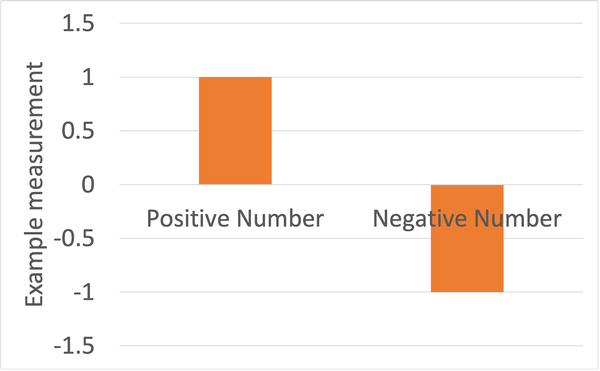 Image Credit: Svenja Lohner, Science Buddies / Science Buddies
Image Credit: Svenja Lohner, Science Buddies / Science Buddies
Figure 6. Example of a bar graph with positive and negative numbers. - Use your data and graphs to answer the following questions:
- Do you see the same trend (pattern) in all three trials? If not, can you think of reasons why?
- How does each type of face mask change the skin moisture on your cheeks?
- What difference do you see between the face mask with and without glycerin?
- Do your results support your hypothesis or not?
- Based on your data, do you think cosmetic face masks that contain glycerin as a humectant are useful for skin hydration?
Ask an Expert
Global Connections
The United Nations Sustainable Development Goals (UNSDGs) are a blueprint to achieve a better and more sustainable future for all.
Variations
- Glycerin is only one hydrating ingredient used in face masks and other moisturizers. Hyaluronic acid is another humectant commonly used. Do you get similar results when adding a hyaluronic acid serum to your mask instead of glycerin? Test it and find out!
- Find out how long the hydrating effect of your mask lasts. Repeat your skin moisture measurements at different time intervals after the mask treatment. For example, measure the skin moisture 5, 15, 30, and 60 minutes after the mask treatment. How long do you think the hydrating effect of the mask will last?
- Measure your skin moisture at different locations in your face. Do you get different results on your forehead or chin? You can also test your hydrogel mask on your hands. Does it have the same effect there?
- Does it matter how much glycerin you add to your hydrogel face mask? Repeat the experiment but make face masks with different glycerin concentrations. Can you increase the hydrating power of your face mask by adding more glycerin to the mask recipe? Remember, keep the total amount of liquid (water plus glycerin) the same for each recipe.
- The effects of hydrogel face masks can vary depending on the skin type. People with oily skin might react differently to face masks than people with dry skin. Test your face masks on different people. Do you get the same results for each one?
- There are many ways to make hydrogel face masks. In this project, you made a hydrogel mask using collagen. There are other substances that can be used to make hydrogel as well, such as agar powder or gelatin. Can you make hydrogel face masks using these materials?
- Face masks often contain more than hydrating ingredients. Find out what other ingredients are commonly added to facial masks. You can read more about different face mask ingredients and their purpose in the Bibliography. Then create your own face mask recipes and test the resulting face masks. How do all the face masks compare? Make sure, however, to only include ingredients that are safe for you and your skin! If you want to get more creative with making your own hydrogel face mask, design your own face mask recipe! In Science Buddies' project Create and Test Your Own Hydrogel Face Mask Recipe! you will use the engineering design process to come up with your own hydrogel face mask recipe.
Careers
If you like this project, you might enjoy exploring these related careers:


